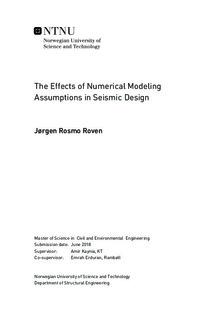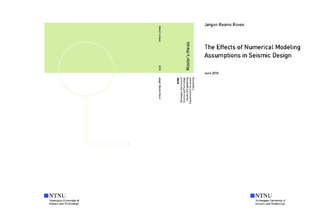| dc.description.abstract | Complex numerical models have been developed during the last decades. They are able
to model complex phenomena that may occur in a structure when subjected to seismic
excitations, including nonlinear material response and the effects of localization. Correct
calibration of the numerical model is essential in order to take advantage of new methods of
analysis. As the models become more complex, more knowledge is required to make the
right assumptions. These assumptions have a large impact on the end results of analyses,
which can lead to inaccurate assessment of damage.
The objective of this work was to investigate the effect of modeling assumptions. This
has been achieved through analysis of a reinforced concrete moment resisting frame. Both
nonlinear time-history analysis (NTHA) and static pushover analysis (SPO) have been
performed, as these methods complement each other. Different model configurations have
been used for these analyses to investigate the effect of their differences. The analyzed
structure is a low-rise building with a high degree of regularity, which legitimize an analysis
of one of its substructures. Hence, all analyses have been carried out on a 2D frame.
Distributed inelasticity elements with fiber sections and complex material models were used.
Results from models using both stiffness and flexibility based beam-column elements were
compared. Along with these models, the novel beam with hinges (BwH) beam-column
element model was used. The OpenSees framework was used as it posses the necessary
capabilities for this kind of study.
Both global and local responses were assessed. The results showed that the modeling
assumptions do have a significant impact on the response. This was observed on both global
and local levels. The resulting response histories of the roof drifts showed that for the force based (FB) elements, when more integration points (IP) were used, the response histories
approached a stable solution. The same could be seen in the inter-story drift ratio (IDR)
profiles sampled when maximum roof drifts occurred. For the BwH model, varying the
hinge lengths resulted in different response histories with sometimes extreme variations.
Importantly, significant differences in the curvature response, which is an important measure
of damage, were also observed for different model configurations.
Among the conclusions drawn from these results, is that six or more IPs should be used
for flexibility based element models when they are being used in a NTHA. Also, it is clear
that measured curvatures are highly sensitive to modeling assumptions. So much in fact,
that assumptions resulting mildly imprecise models may lead to unfortunate assessment of
damage. The results show that attention to detail is important when a numerical model is to
be constructed and that the analyst must have knowledge of the numerical issues that may
arise in order to arrive at a correct assessment. Further work is necessary to quantify the
effects of modeling assumptions. | |

